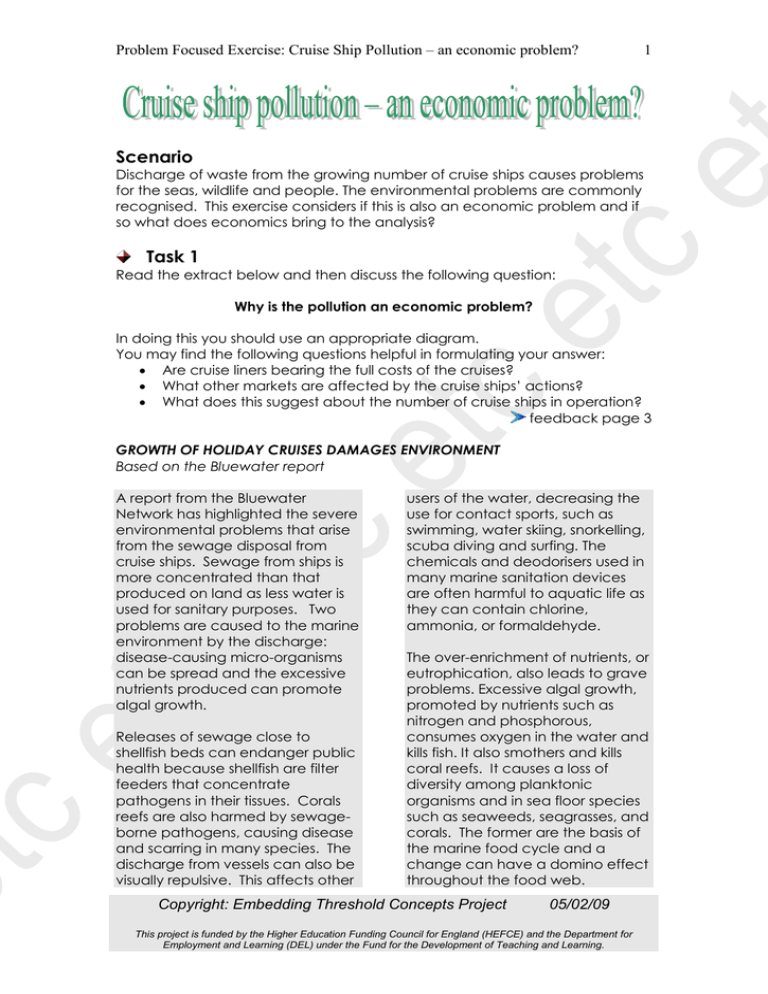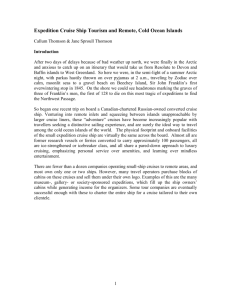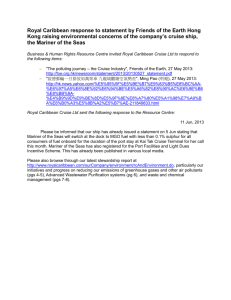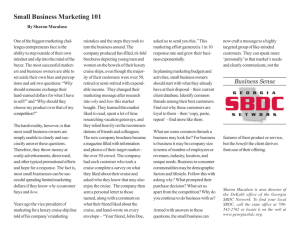Scenario Problem Focused Exercise: Cruise Ship Pollution – an economic problem? 1
advertisement

Problem Focused Exercise: Cruise Ship Pollution – an economic problem? 1 Scenario Discharge of waste from the growing number of cruise ships causes problems for the seas, wildlife and people. The environmental problems are commonly recognised. This exercise considers if this is also an economic problem and if so what does economics bring to the analysis? Task 1 Read the extract below and then discuss the following question: Why is the pollution an economic problem? In doing this you should use an appropriate diagram. You may find the following questions helpful in formulating your answer: Are cruise liners bearing the full costs of the cruises? What other markets are affected by the cruise ships’ actions? What does this suggest about the number of cruise ships in operation? feedback page 3 GROWTH OF HOLIDAY CRUISES DAMAGES ENVIRONMENT Based on the Bluewater report A report from the Bluewater Network has highlighted the severe environmental problems that arise from the sewage disposal from cruise ships. Sewage from ships is more concentrated than that produced on land as less water is used for sanitary purposes. Two problems are caused to the marine environment by the discharge: disease-causing micro-organisms can be spread and the excessive nutrients produced can promote algal growth. Releases of sewage close to shellfish beds can endanger public health because shellfish are filter feeders that concentrate pathogens in their tissues. Corals reefs are also harmed by sewageborne pathogens, causing disease and scarring in many species. The discharge from vessels can also be visually repulsive. This affects other users of the water, decreasing the use for contact sports, such as swimming, water skiing, snorkelling, scuba diving and surfing. The chemicals and deodorisers used in many marine sanitation devices are often harmful to aquatic life as they can contain chlorine, ammonia, or formaldehyde. The over-enrichment of nutrients, or eutrophication, also leads to grave problems. Excessive algal growth, promoted by nutrients such as nitrogen and phosphorous, consumes oxygen in the water and kills fish. It also smothers and kills coral reefs. It causes a loss of diversity among planktonic organisms and in sea floor species such as seaweeds, seagrasses, and corals. The former are the basis of the marine food cycle and a change can have a domino effect throughout the food web. Copyright: Embedding Threshold Concepts Project 05/02/09 This project is funded by the Higher Education Funding Council for England (HEFCE) and the Department for Employment and Learning (DEL) under the Fund for the Development of Teaching and Learning. Problem Focused Exercise: Cruise Ship Pollution – an economic problem? 2 Task 2 Read the short extract and consider the following: (i) What are the problems identified with the policy being used to control pollution? (ii) Do the problems stem from generic difficulties with this policy approach that will apply in other situations, or are they specific to this case? (iii) From an economic viewpoint, should the dumping of greywater be banned everywhere? feedback page 4 ENVIRONMENTAL LAWS FLOUTED Based on the Bluewater report The Bluewater report goes onto consider how fleets of cruise ships have been not only damaging the environment, but also breaking the law. The report gives the disturbing example of Royal Caribbean Cruises Ltd. This company admitted that over a number of years they had routinely dumped noxious pollutants into several US harbours and coastal areas. The substances included waste oil, hazardous chemicals from photo processing labs, dry cleaning operations and print shops. The report explains how this was carried out by secret piping systems in the ships to bypass pollution treatment equipment. Investigators considered the company's dishonest behaviour was so pervasive that the criminal conduct amounted to routine business practice. They regarded the case as a ‘fleet-wide conspiracy’ by Royal Caribbean to ‘use our nation's waterways as its dumping ground’. In the resulting prosecution the company pleaded guilty to 21 offences in six US jurisdictions. They agreed to pay a record $18 million in fines. As well as the flouting of the law by companies, there are problems with the law’s coverage. Problematically, several types of cruise ship discharges are exempt from key regulations governing other wastewater dischargers. Both the cruise ship industry and the environmental agencies seem unclear on what laws do and do not apply to the management and disposal of these wastes. The report argues that current controls are not strong enough because there are numerous gaps in environmental laws and loopholes in the regulations that should be controlling pollution by cruise ships. For instance, greywater can lawfully be dumped anywhere except the Great Lakes, even though greywater has the potential to cause detrimental environmental effects. (Greywater is non-industrial wastewater generated by processes such as dish washing, laundry and bathing, but not toilets.) Both the extracts are based on: CRUISING FOR TROUBLE: STEMMING THE TIDE OF CRUISE SHIP POLLUTION, report prepared by Kira Schmidt, BLUEWATER NETWORK, March 2000. The full report can be obtained from: http://bluewaternetwork.org/reports/rep_ss_cruise_trouble.pdf Copyright: Embedding Threshold Concepts Project 05/02/09 This project is funded by the Higher Education Funding Council for England (HEFCE) and the Department for Employment and Learning (DEL) under the Fund for the Development of Teaching and Learning. Problem Focused Exercise: Cruise Ship Pollution – an economic problem? 3 Feedback Task 1 Pollution is not an economic problem simply because it is ‘bad’ environmentally. People going on cruises presumably enjoy them (and they see them as being worth at least the price they have paid for the trip). From an economics viewpoint this is beneficial, even if it does cause pollution. However, there are some other important economic factors to take into consideration that do suggest an economic problem exists. Are cruise liners bearing the full costs of the cruises? No. The dumping of the greywater and in some cases more noxious substances is a cheap method of waste disposal for the cruise ships, lowering their costs and prices (and increasing the quantity). Importantly, water is being treated as a ‘free’ good, but in fact clean water is a scarce commodity and there is an opportunity cost involved. What other markets are affected by the cruise ships actions? Fishermen, swimmers, etc. who are not involved in the market transaction (the market for cruises) are being adversely affected. These are ‘third party’ or ‘externality’ effects and these are a problem of welfare economics. What does this suggest about the number of cruise ships in operation? The price mechanism is not sending the correct signals and we have what is known as market failure and an over-supply of cruises. We can use figure 1 to show the effect. We draw the demand and supply curves in the standard way (the numbers are purely illustrative). The cruise ship market only takes into account its private costs, giving a price of £2,000 and 6,000 cruise passengers. However, if we include all costs, including the opportunity cost of the waste disposal, this would shift the supply curve to the left and price would be higher at £2,200 and the number of cruise passengers would be reduced to 5,000. At the moment cruise passengers are ‘getting it on the cheap’ and not paying the full costs of their cruises and this means fewer resources available to others. Figure 1: The market for cruise ships Price £ Supply including private and externality cost Supply including only private costs 2200 2000 Demand 5 6 Quantity (thousands of passengers) Copyright: Embedding Threshold Concepts Project 05/02/09 This project is funded by the Higher Education Funding Council for England (HEFCE) and the Department for Employment and Learning (DEL) under the Fund for the Development of Teaching and Learning. Problem Focused Exercise: Cruise Ship Pollution – an economic problem? 4 Feedback Task 2 What is the rationale for government intervention? In task 1 we considered how the problem was an externality that gave rise to market failure. This welfare economics problem means that the unfettered price mechanism is not sending the correct signals and there is an arguable case for government intervention. If the legislation is successful it will raise the cruise ships’ costs in having to deal with the waste water, leading the supply curve to move to the left and prices of cruises to rise (a movement towards the supply curve that includes the externality costs in figure 1). What are the problems with using legislation as a control? Simply passing a law will not necessarily stop the market operating as there are incentives for firms to cheat. Without adequate policing the policy becomes optional. The problem (including the cost) of obtaining information on dumping is also an important aspect. Should all greywater dumping be banned? From an economics viewpoint, it does not necessarily mean that dumping greywater should be banned. This depends on the costs and benefits, including any costs of policing legislation. Reducing, rather than banning, may reduce the negative side-effects dramatically and we should not lose sight of the fact that people do seem to like cruises! Reflection Yes Partly No 1. Can you distinguish the concept of an externality from a pure environmental effect? 2. Cruise ships do not pay for their use of the sea for waste disposal. Do you understand why this is a problem? 3. Did your diagram illustrate the market failure? If your answer is ‘No’ or ‘Partly’ to any of the above, which of the following do you now intend to do to improve your understanding? 1. Ask for guidance from my tutor? 2. Read a relevant section in a textbook? 3. Work though some example questions? Copyright: Embedding Threshold Concepts Project 05/02/09 This project is funded by the Higher Education Funding Council for England (HEFCE) and the Department for Employment and Learning (DEL) under the Fund for the Development of Teaching and Learning. Problem Focused Exercise: Cruise Ship Pollution – an economic problem? 5 Notes for lecturers Objectives of the exercise and prerequisites Learning Focus: Appreciating why pollution is an economic problem and developing an understanding of markets, incentives and market failure. The aim is to get students using economic ideas rather than focusing on the environmental details. Threshold Concepts that are pivotal to this learning are welfare economics and incentives. The threshold concept interaction between markets is also used. Prior Knowledge Required Students need an understanding of demand and supply. It can be used without prior knowledge of concepts such as externalities as a way of introducing the topic. Alternatively it can be used as reinforcement of ideas introduced in a lecture. Sequencing and timing 1. Task 1 asks students to read the extract and then answer a question. A number of subsidiary questions are provided to help students through the analysis. 2. The task can be carried out on an individual basis but students may benefit from working in groups. Students can be asked to give a presentation of their findings to encourage participation (this can be certain selected groups rather than all in order to fit the time scheduling). 3. It is possible to set task 1 without task 2. Task 1 is on the economic problem of pollution and task 2 is on the problem of enforcing policies to reduce this. 4. Feedback for task 1 should be given before students attempt task 2. 5. If task 1 is carried out in groups and time is given for around three short presentations by student groups, the exercise is likely to take 40 minutes. Otherwise the full task can be done in this time. Copyright: Embedding Threshold Concepts Project 05/02/09 This project is funded by the Higher Education Funding Council for England (HEFCE) and the Department for Employment and Learning (DEL) under the Fund for the Development of Teaching and Learning.



